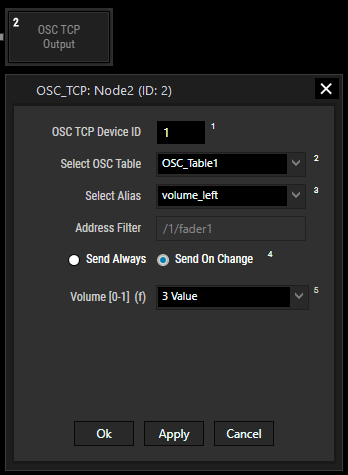Loading...
The OSC TCP Output node allows you to send OSC messages to an OSC device. The remote device needs to be connected to an OSC TCP device in the Configuration dialog. Further an OSC Table needs to be added and setup in the Configuration dialog in order to send messages with this node. The OSC TCP Input node allows receiving messages.
This node can be found under Nodes > Output > Devices > OSC TCP Output

OSC TCP Device ID:
Choose the ID of an OSC TCP device in the Configuration dialog.
Select an OSC Table from the Configuration dialog.
Depending on above OSC Table, the drop-down list shows all available "Alias" entries. An "Alias" references the defined OSC address (see field "Address Filter") and defined parameter types. When an Alias is selected, each of its parameters is dynamically added to the node dialog in the form of a labeled drop-down list allowing to select an input value.
As an example, the Alias "volume_left" defined the OSC address "/1/fader1" with a single float parameter. Hence, one drop-down list is added to the bottom and labeled "Volume [0-1]" just as entered in the OSC Table before. When the node is connected to other input or filter nodes, you can choose as input value that is sent to the address "/1/fader1".
Choose when a message is sent out. The "Always" option sends continuous messages, whilst "On Change" is triggered, when one of the input values changes.
With Widget Designer version 6, all nodes support so called node commands. Node commands access functions (i.e methods) from a node and / or set a parameter (i.e. property).
Enter "node", followed by the according ID and a dot and a list will pop up showing all available commands for the node. For instance, Node1.TintColor.SetRGB(125,0,255), colors the node in purple.
In addition, the node properties with a parameter ID (the small superscript number) can be edited via the command Node1.SetParam(ID,new Value) or WDNodeSetParam(NodeID,ParamID,Value).